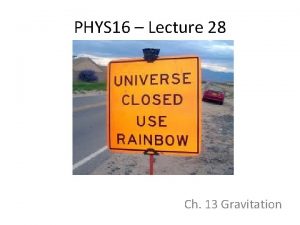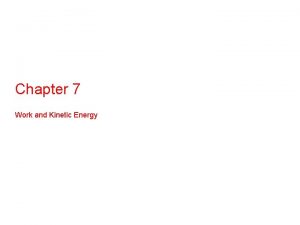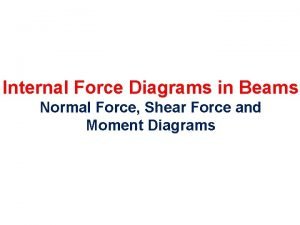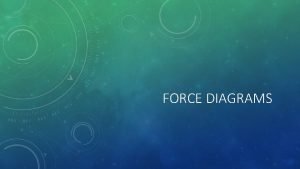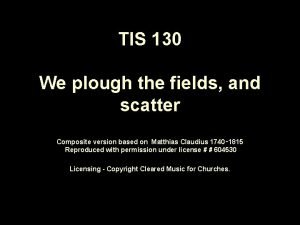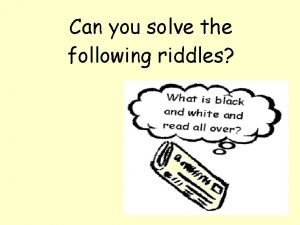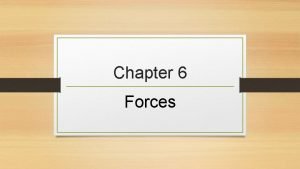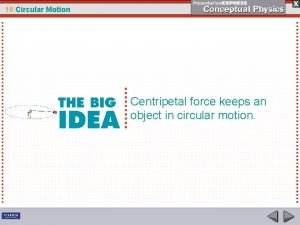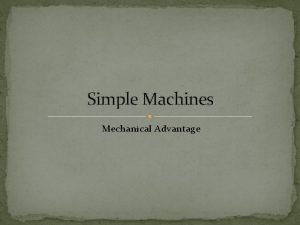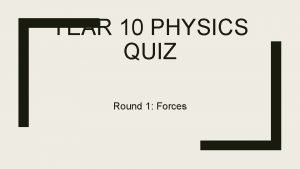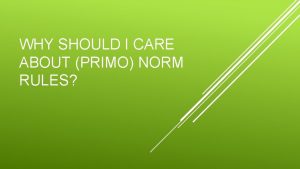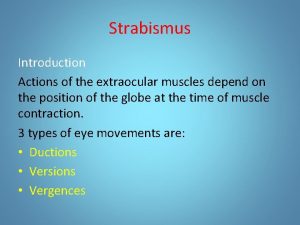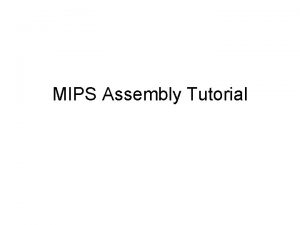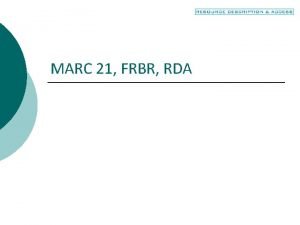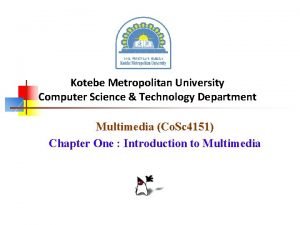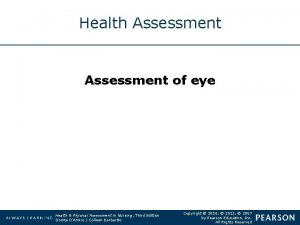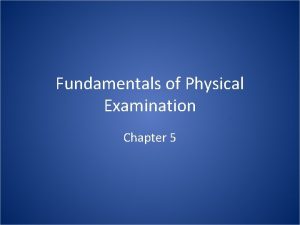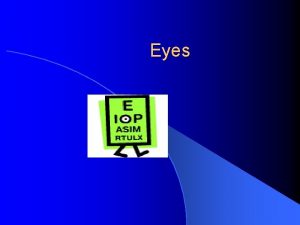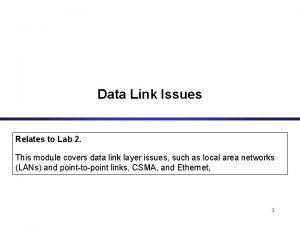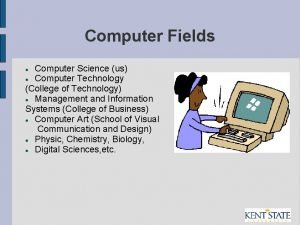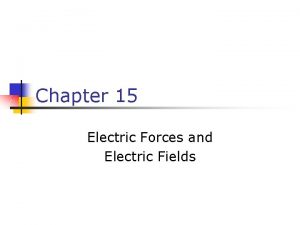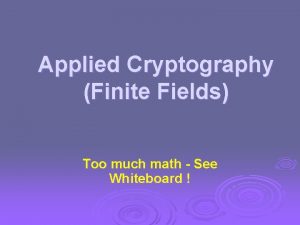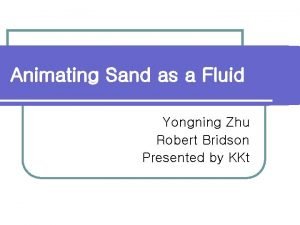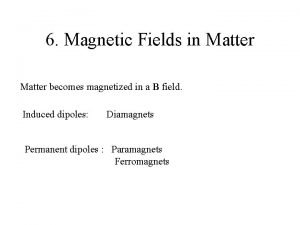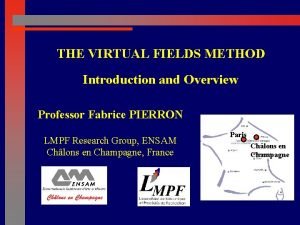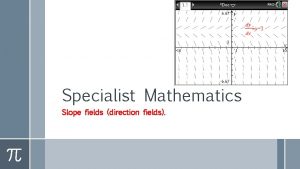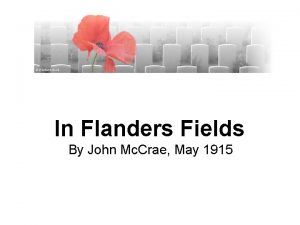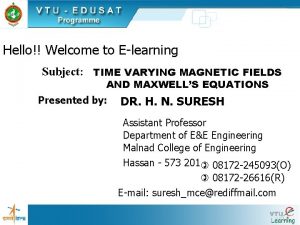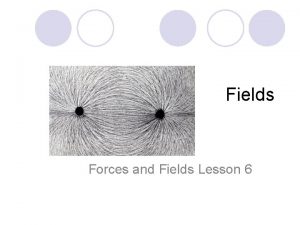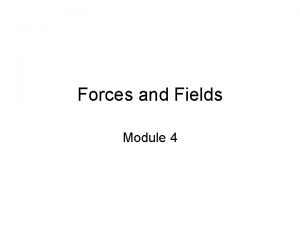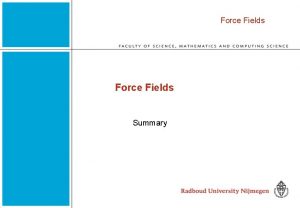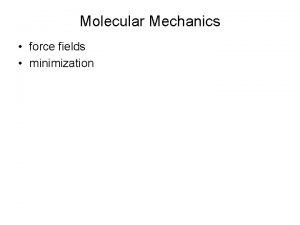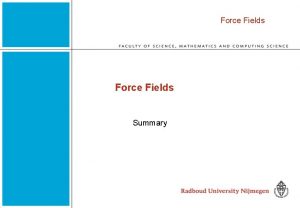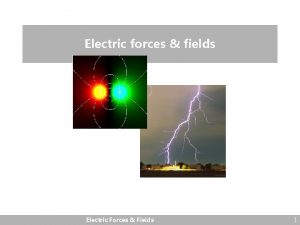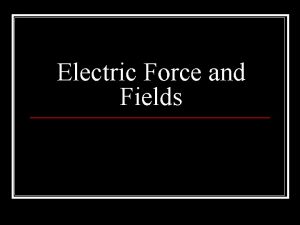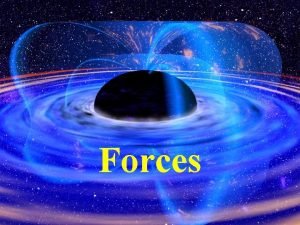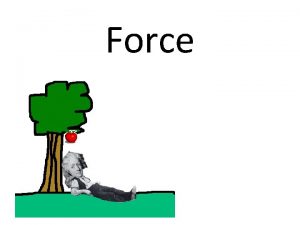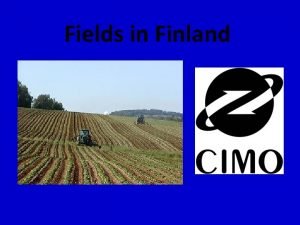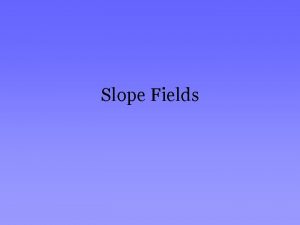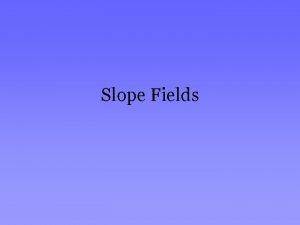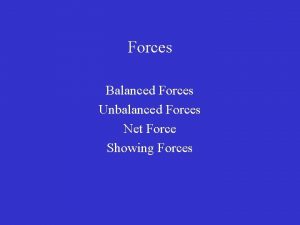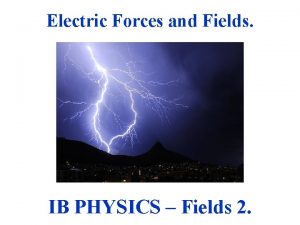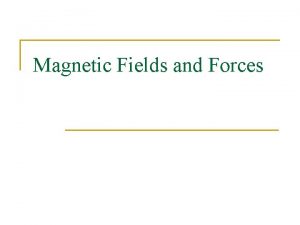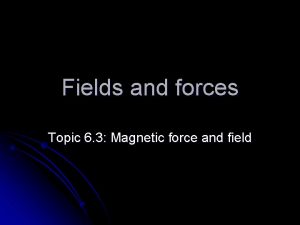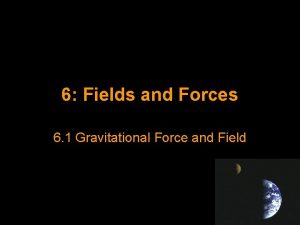Forces Forces and Fields A Force is a


































































- Slides: 66

Forces

Forces and Fields • A Force is a push or a pull • A Force Field is an area in which a force is experienced.

Vectors and Scalars • Vectors are quantities that have both magnitude and direction. • For example: Velocity: 45 mph West • Scalars are quantities that just have magnitude • For example: Speed 45 mph • Why use vectors? ? • They show the forces acting on an object. We can add them or subtract them to determine the Net force acting on an object.


Newton's st 1 Law • An object in motion stays in motion, an object at rest stays at rest, unless acted upon by an outside force(net force). • This is also called the law of inertia. • Inertia is the resistance of a body to change its motion, and it only depends on the MASS of the object.

Newton’s • • nd 2 Law F=ma. IF we rearrange this formula we get: m= F/a a=F/m • Where : F = Force in Newtons (N) • m= mass in kilograms (kg) • a= acceleration in meters per second squared (m/ss)

Newton’s rd 3 Law • For every action there is an equal and opposite reaction. • Think of forces as interacting pairs, if Mr. I punches the wall with a force of 20 N, the wall will push back on Mr. I’s hand with a 20 N(equal) and opposite force. • Although the forces are equal and opposite, they can still cause an object to move because they act on different OBJECTS. • For instance, in the example above Mr. I’s hand the wall are the two objects having the force being applied to it. Both can move.

Types of Forces

Contact vs Non-Contact Forces • All Forces can be broken up into contact and non-contact forces • Contact forces are those types of forces that result when the two interacting objects are perceived to be physically contacting each other • Non-contact forces are those types of forces that result even when the two interacting objects are not in physical contact with each other, yet are able to exert a push or pull despite their physical separation.

Contact vs Non-Contact Forces Contact • • • Friction Normal Tension Air Resistance Applied Force Spring Force Non- Contact • Gravitational Force • Electrical Force • Magnetic Force

Applied Force • An applied force is a force that is applied to an object by a person or another object. • This is the force that an outside object applies on an object. • This is a contact force

Gravity Force • Otherwise known as the Weight of an object. • Attractive force between all objects with mass • All objects on earth are accelerated downwards at the same speed regardless of their weight and mass. • Force of gravity is always downward • Fg = w =mg mass in kg • Where gearth= 9. 8 m/ss

Friction Force • the force exerted by a surface as an object moves across it or makes an effort to move across it. • There are two main types : • 1 - Static Friction – Force keeping objects at rest. If you are to move any object you must overcome the force of static friction. • 2. Kinetic Friction – Force that acts on objects in motion, causing heat.

Co-efficient of Friction • The values of μ provide a measure of the relative amount of adhesion or attraction of the two surfaces for each other. The more that surface molecules tend to adhere to each other, the greater the coefficient values and the greater the friction force. • THIS HAS NO UNITS!!!

Different Types of Friction 1. Static Friction • when a force is applied to an object but it does not cause it to move example: pushing on a wall 2. Fluid Friction • occurs when a object moves through a fluid, meaning either a liquid or gas examples: skydiving, swimming 3. Sliding Friction • occurs when solid surfaces slide over each other example: falling on the pavement 4. Rolling Friction • occurs when an object rolls over another (something with wheels or that is circular like a ball) example: riding a motorcycle

Air Resistance • This is a form of fluid friction • It is the frictional force caused by the rubbing of the air and a moving object. • Depends on velocity of an object and surface area, but hard to predict. • Forces are balanced in this situation • Also know as drag when the object has a horizontal component of motion in air.

Tension Force • The tension force is the force that is transmitted through a string, rope, cable or wire when it is pulled tight by forces acting from opposite ends. • The tension force is directed along the length of the wire and pulls equally on the objects • on the opposite ends of the wire.

The Normal Force • The Normal force is perpendicular to the surface always! • On a flat surface it is equal to the Weight of the object. • Fnormal= w=FG =W

On an inclined plane notice the forces acting on the block. • The weight(mg) always acts directly vertically, that is why we get pulled down a ramp. • The normal force is still perpendicular to the surface.

Spring Force • The spring force is the force exerted by a compressed or stretched spring upon any object that is attached to it • Hooke’s Law : the magnitude of the force is directly proportional to the amount of stretch or compression of the spring. • See Colorado Simulation

What is a force field? • An area in which a force is experienced. • Also known as a non-contact force

3 Types of Fields : 1. Gravitational Field 2. Electrical Field 3. Magnetic Field Before we talk about these fields we need to learn some general information about each of these fields.

1. Gravitational Field • • This is a field caused by the attraction between two object with Mass. Gravity is the attractive force between two objects with mass Gravity is a vector quantity because it has both magnitude and direction. There are two factors that effect the strength of gravitational field, and these are 1. Mass of each object. 2. The distance between the two objects. • The greater the mass = stronger the gravitational force • The greater the distance = weaker the gravitational force


2. Electrical Force • This is the force exerted on a charged body. • Strength of a electrical force depends on the: 1. Amount of charge and 2. The distance between the two charged bodies. • The greater the charge the stronger the force • The smaller the distances are between the two charged bodies, the stronger the electrical force

Law of Charges • Un. Like charges Attract and like charges Repel!!



3. Magnetic Field • There are three types of magnets: 1) Permanent Magnets 2) Temporary 3)Electromagnets A magnetic field is an area in which a force acts on a magnetic body.




Dynamics and Motion

Balanced Forces and Unbalanced Forces • Balanced Forces results in either no movement or constant velocity(acceleration=0). • Unbalanced Forces require a net force and results in acceleration of an object.

Vocabulary • • • Displacement Velocity Acceleration Time Instantaneous Speed Reference Frame

Reference Frame • A reference point is needed to describe motion. This is a point from which all motion will be described. Ex…. The motion of the mail truck would be different if it was referenced from a moving car rather than a stationary mailbox. • A Frame of Reference is a coordinate system in which the position of the object is measured. The x and y-axis of the reference frame are drawn so they intersect the reference point.


Displacement • Displacement is the shortest distance from the starting position an object has moved. • This is a vector quantity, meaning it has both magnitude and direction

What is the distance if traveled to? : a) B b) C c) D

Speed vs Velocity Speed • This is the change in DISTANCE over time. • This is a scalar, meaning…. • s=d/t • Ex. . 45 mph Velocity • This is the change in DISPLACEMENT over time. • This is a vector, meaning….

Instanteous Speed

Calculating Speed • A football field is about 100 m long. If it takes a person 20 seconds to run its length, how fast (what speed) were they running?

Calculating Distance • If you drive at 100 km/hr for 6 hours, how far will you go?

Calculating time Every summer I drive to Michigan. It is 3900 km to get there. If I average 100 km/hr, how much time will I spend driving?

Acceleration • • Acceleration is the change in velocity over time. aavg=(vf - vi)/(tf- ti) Where: vf= final velocity vi= initial velocity tf= final time(s)ti= initial time(s)

Calculating Accelerating • A bus slams on its breaks and goes from 30 km/hr to 15 km/hr in 4 seconds. What is its acceleration?

Questions for Consideration l What is a position-time graph? l What is a velocity-time graph? l How do features on one graph translate into features on the other?

Position-Time Graphs l Show an object’s position as a function of time. l l x-axis: time y-axis: position

Position-Time Graphs l Imagine a ball rolling along a table, illuminated by a strobe light every second. 0 s 1 s 2 s l 3 s 4 s 5 s 6 s 7 s 8 s You can plot the ball’s position as a function of time. 9 s 10 s

Position-Time Graphs 10 9 position (cm) 8 7 6 5 4 3 2 1 1 2 3 4 5 6 7 8 9 10 time (s)

Position-Time Graphs l What l Straight line, upward slope l What kind of motion created this graph? l Constant speed 10 9 8 7 position (cm) are the characteristics of this graph? 6 5 4 3 2 1 time (s) 1 2 3 4 5 6 7 8 9 10

Position-Time Graphs l Each type of motion has a characteristic shape on a PT graph. Constant speed l Zero speed (at rest) l Accelerating (speeding up) l Decelerating (slowing down) l

Position-Time Graphs time (s) Constant speed in positive direction. pos. (m) speed is represented by a straight segment on the P-T graph. pos. (m) l Constant time (s) Constant speed in negative direction.

Position-Time Graphs speed is represented by a straight segment on the P-T graph. pos. (m) l Constant time (s) A horizontal segment means the object is at rest.

Position-Time Graphs time (s) Speeding up in positive direction. pos. (m) segments on the P-T graph mean the object’s speed is changing. pos. (m) l Curved time (s) Speeding up in negative direction.

Position-Time Graphs time (s) Traveling in positive direction, but slowing down. pos. (m) segments on the P-T graph mean the object’s speed is changing. pos. (m) l Curved time (s) Traveling in negative direction, but slowing down.

Position-Time Graphs l The slope of a P-T graph is equal to the object’s velocity in that segment. slope = 50 position (m) change in y 40 30 slope = change in x (30 m – 10 m) 20 10 slope = 10 20 time (s) 30 (30 s – 0 s) (20 m) (30 s) 40 slope = 0. 67 m/s

Position-Time Graphs The following P-T graph corresponds to an object moving back and forth along a straight path. Can you describe its movement based on the graph? N position (m) l S time (s)

Velocity-Time Graphs l. A velocity-time (V-T) graph shows an object’s velocity as a function of time. A horizontal line = constant velocity. l A straight sloped line = constant acceleration. l l l Positive slope = positive acceleration. l l Acceleration = change in velocity over time. Not necessarily speeding up! Negative slope = negative acceleration. l Not necessarily slowing down!

Velocity-Time Graphs l. A horizontal line on the V-T graph means constant velocity (m/s) N S time (s) Object is moving at a constant velocity North.

Velocity-Time Graphs l. A horizontal line on the V-T graph means constant velocity (m/s) N S time (s) Object is moving at a constant velocity South.

Velocity-Time Graphs an object isn’t moving, its velocity is zero. N velocity (m/s) l If S Object is at rest time (s)

Velocity-Time Graphs l If the V-T line has a positive slope, the object is undergoing acceleration in positive direction. If v is positive also, object is speeding up. l If v is negative, object is slowing down. l

Velocity-Time Graphs graph has positive slope. S time (s) Positive velocity and positive acceleration: object is speeding up! velocity (m/s) N N velocity (m/s) l V-T S time (s) Negative velocity and positive acceleration: object is slowing down.

Velocity-Time Graphs l If the V-T line has a negative slope, the object is undergoing acceleration in the negative direction. If v is positive, the object is slowing down. l If v is negative also, the object is speeding up. l

Velocity-Time Graphs graph has negative slope. S time (s) Positive velocity and negative acceleration: object is slowing down, velocity (m/s) N N velocity (m/s) l V-T S time (s) Negative velocity and negative acceleration: object is speeding up! (in negative direction)
 Red fields to green fields
Red fields to green fields Electric forces and fields concept review
Electric forces and fields concept review Learning: module 26: magnetic forces and fields
Learning: module 26: magnetic forces and fields Chapter 16: electric forces and fields answers
Chapter 16: electric forces and fields answers Centripetal force and gravitational force
Centripetal force and gravitational force Normal force and gravitational force
Normal force and gravitational force Normal force and shear force
Normal force and shear force Free body
Free body Resultant of two unlike parallel forces
Resultant of two unlike parallel forces Contact vs noncontact forces
Contact vs noncontact forces Force examples in everyday life
Force examples in everyday life Is erosion a constructive force
Is erosion a constructive force We plough the fields and scatter
We plough the fields and scatter Rodan and fields tax write offs
Rodan and fields tax write offs Lesson outline magnets and magnetic fields answer key
Lesson outline magnets and magnetic fields answer key Solve the following riddles
Solve the following riddles Maxwell equations for time varying fields
Maxwell equations for time varying fields Branches and fields of psychology
Branches and fields of psychology Conceptual physics chapter 33
Conceptual physics chapter 33 Multiplicative inverse
Multiplicative inverse Electric currents and magnetic fields
Electric currents and magnetic fields Visualizing magnetic field
Visualizing magnetic field Contact vs noncontact forces
Contact vs noncontact forces Which arrow below represents the direction of acceleration
Which arrow below represents the direction of acceleration Long range force vs contact force
Long range force vs contact force If you whirl a tin can on the end of a string
If you whirl a tin can on the end of a string How does mechanical advantage work
How does mechanical advantage work Unbalanced force
Unbalanced force Centripetal force vs centrifugal
Centripetal force vs centrifugal Is air resistance a contact force
Is air resistance a contact force Why electric field is conservative
Why electric field is conservative Which of the following forces is a contact force? *
Which of the following forces is a contact force? * The forces shown above are
The forces shown above are Intermolecular forces vs intramolecular forces
Intermolecular forces vs intramolecular forces Interu
Interu Intermolecular force of attraction
Intermolecular force of attraction Norm rule fields
Norm rule fields How many fields in computer science
How many fields in computer science Breath sounds location
Breath sounds location Latent squint meaning
Latent squint meaning 6 cardinal fields of gaze
6 cardinal fields of gaze Poem stealing
Poem stealing Slope fields ap calculus
Slope fields ap calculus Mips architecture tutorial
Mips architecture tutorial Frbr examples
Frbr examples Kotebe metropolitan university departments
Kotebe metropolitan university departments Six cardinal fields of gaze
Six cardinal fields of gaze Tactile fremitus
Tactile fremitus L
L Custom fields empower 3
Custom fields empower 3 Tumor treating fields mechanism of action
Tumor treating fields mechanism of action Ethernet ii frame fields
Ethernet ii frame fields How many fields in computer science
How many fields in computer science Electric fields quiz
Electric fields quiz Finite fields in cryptography
Finite fields in cryptography Animating sand as a fluid
Animating sand as a fluid Binary fields
Binary fields Magnetic fields in matter
Magnetic fields in matter How to do slope fields
How to do slope fields Virtual fields method
Virtual fields method Virtual fields method
Virtual fields method How to graph slope field on ti nspire cx
How to graph slope field on ti nspire cx Please fill all fields
Please fill all fields Into the fields internship
Into the fields internship In flanders fields summary
In flanders fields summary Equation of continuity for time varying fields
Equation of continuity for time varying fields Happy autumn fields
Happy autumn fields




